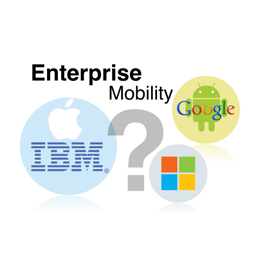How Apple's device strategy is making an impact on the enterprise

Since the advent of B.Y.O.D (Bring Your Own Device) schemes and the success of the iPhone as both a consumer and business device, Apple has recognised the need to strengthen its portfolio of enterprise-friendly device management tools, productivity applications and not least its IT support.
The iPhone and iPad have propelled Apple to widespread adoption in corporate markets such as Education, Healthcare and Government. But needless to say, satisfying the needs and desires of users (who want freedom of choice, simplicity and a familiar user experience) and IT administrators (robust security, ease of configuration and the ability to manage devices remotely) can be a delicate balance.
Since the demise of Blackberry, IT departments have had little choice but to accept the iPhone in the workplace, leading to concerns about managing employees’ iOS devices that need to be addressed. It seems that Apple is slowly becoming more open and enterprise-friendly with greater transparency and a focus on creating productivity tools (the iWork suite), and by adding more flexible security features in iOS 8.
Big Blue and Apple Global Partnership
Back in July, IBM and Apple announced a high profile partnership focused around Enterprise Mobility. In a collaboration that should promote competition in the enterprise market, the deal draws on the strengths of each – IBM’s “big data” analytics and track record in corporate IT solutions, coupled with Apple’s expertise in customer experience, development platforms and of course its unmatched app ecosystem.
IBM will no doubt leverage its existing products and services such as MaaS360 – a cloud-based mobile device management (MDM), application management and expense management offering.
For the first time ever we’re putting IBM’s renowned big data analytics at iOS users’ fingertips, which opens up a large market opportunity for Apple. This is a radical step for enterprise and something that only Apple and IBM can deliver – Tim Cook, Apple CEO.
Marketed as IBM MobileFirst for iOS, the partnership offers:
- Creation of 100 industry-specific enterprise solutions such as native “made for business” apps
- Integration with IBM’s cloud-based services
- New packaged offerings for device activation, supply and management (Mobile Device Management)
- AppleCare for Enterprise on-site support and device procurement services
But what does this mean in practice?
In short, IBM will help to fill in the missing pieces in Apple’s portfolio and provide a more rounded, comprehensive level of round-the-clock support. Examples include managed applications and extensions that can be automatically configured during or after installation (e.g. to handle new mail or WiFi settings) in addition to secure document sharing. In this case, employee policy and benefits documents could be pushed into iBooks, and selected apps could be restricted from synchronising data and documents with Apple’s own iCloud.
Apple’s strategy of partnering with IBM will no doubt benefit both firms and may help iOS retain its footprint in the enterprise. But in the face of stiff competition, especially from Google’s Android, they may face an uphill battle…
Enterprise Mobility – the Winners and Losers
According to Apple, 98% of Fortune 500 companies and 92% of Global 500 firms use iOS in their businesses every day. While it’s hard to dispute such claims, it’s clear that Android has started to invade the Enterprise market and is already catching up.
According to Good Technology’s Mobility Index report issued in August, iOS use in the Enterprise fell by 5% to 67% of total device activations with Android rising by 5% to 32% of total activations. Windows Phone remained flat with an unremarkable 1%.

Can Google and Microsoft Challenge Apple in the Enterprise?
Android is steadily gaining enterprise share, partly due to better built-in security (Samsung is allegedly contributing elements of its cloud-based Knox security product to Android L) that is helping combat concerns about rampant malware on the platform. Google also acquired New York firm Divide earlier this year – a BYOD device management provider that Google could use to raise awareness of its improving security image.
Unfortunately, some companies’ IT admins are still reluctant to support Android; those that do tend to choose a limited selection of devices rather than opening the field to every manufacturer and version of the operating system. By focusing on just a few select models, it’s far easier to control configuration and deployment of applications, access to corporate networks, and to white or black-list apps.
Google now needs to maintain the momentum, possibly by expanding its office products and enterprise mobile apps, but it could also partner with a professional services provider such as HP or Dell.
Microsoft
Microsoft has been entrenched in the desktop enterprise space for years, but since it acquired Nokia Devices has shifted to a more cloud and mobile-centric strategy. The advantage Microsoft has is its deep understanding of the complex needs of IT departments, but it needs to capitalise on that experience to augment its Windows Phone position.
Our job is to ensure Microsoft will thrive in a mobile and cloud-first world – Satya Nadella, Microsoft CEO
Back in March of this year, Microsoft announced its Enterprise Mobility Suite (EMS) which, amongst other benefits, helps IT admins deploy configuration policies, email and Office 365 accounts, install security certificates and update network profiles. Windows Phone 8.1 even includes a built in device management client; this allows Windows Phone to integrate with existing management solutions such as the Azure Active Directory and a single sign-on to make it easier for employees to access company applications and documents.
And in a nod to the popularity of iOS, Microsoft capitalised on the popularity of Office by releasing a freemium version for the iPhone and iPad, tying users into those products and ensuring that, even if Windows Phone still has some way to go, Microsoft can still benefit from Apple’s rise in the enterprise.
While Windows Phone is considered strong in terms of enterprise applications, security and management capabilities, now all Microsoft needs to do is to sell more smartphones…




